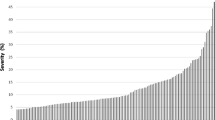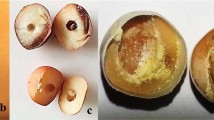Abstract
Key message
The resistance to Diamondback moth insect in cabbage is governed by many minor loci in quantitative nature, and at least four genetic loci should be incorporated in marker-assisted breeding program for developing partially resistant DBM cabbage cultivars.
Abstract
The Diamondback moth (DBM), Plutella xylostella (L.), is the most destructive insect infesting cruciferous plants worldwide. Earlier studies have reported that the glossy leaves of cabbage are associated with resistance to this insect. However, until now, genetics of DBM resistance has not been studied in detail, and no QTL/gene mapping for this trait has been reported. In this paper, we report quantitative trait loci (QTL) mapping of DBM-resistant trait using 188 randomly selected segregating F 3 population derived from crossing a partially DBM-resistant glossy leaf cabbage (748) with a susceptible smooth cabbage line (747). Quantitative trait loci mapping using phenotypic data of four consecutive years (2008, 2009, 2010, and 2011) on DBM insect infestation detected a total of eight QTL on five linkage groups suggesting that DBM resistance is a quantitative in nature. Of these QTL, four QTL, i.e., qDbm 1 on LG1, qDbm5 and qDbm6 on LG7, and qDbm8 on LG9, were detected in different tests and years. The QTL, qDbm6 on LG7, was consecutively detected over 3 years. Tightly linked molecular markers have been developed for qDbm8 QTL on LG9 which could be used in marker-assisted breeding program. Our research demonstrated that for desired DBM resistance cultivar breeding, those four genetic loci have to be taken into consideration. Furthermore, the comparative study revealed that DBM resistance QTL is conserved between close relative model plant Arabidopsis thaliana and Brassica oleracea genome.





Similar content being viewed by others
References
APRD (2012) Arthropod Pesticide Resistance Database. East Lansing: Michigan State University. http://www.pesticideresistance.com/index.php. Accessed 12 Dec 2013
Asghari A, Fathi AA, Mohammadi SA, Mohammaddust H (2009) QTL analysis for diamondback moth resistance in canola (Brassica napus L.). Int J Plant Prod 3:1735–6814
Dickson MH, Eckenrode CJ (1980) Breeding for resistance in cabbage and cauliflower to cabbage looper, imported cabbageworm and diamondback moth. J Am Soc Hortic Sci 105:782–785
Dickson MH, Eckenrode CJ, Lin J (1986) Breeding for diamondback moth resistance in Brassica oleracea. First Intl Diamondback Moth Wrks Asian Vegetable Res & Dev Ctr, Shanhua, pp 137–143
Dickson MH, Shelton AM, Eigenbrode SD, Vamosy ML, Mora M (1990) Breeding for resistance to diamondback moth, Plutella xylostella, in cabbage. Hort Sci. 25:1643–1646
Eckenrode CJ, Dickson MH, Lin J (1986) Resistance in crucifers to diamondback moth and other lepidopterous pests. In: Talekar NS, Griggs TD (eds) Diamondback Moth Management, proceedings of the first international workshop. Asian Vegetable Research and Development Center, Shanhua, Taiwan, pp 129–136
Eigenbrode SD, Espelie KE (1995) Effects of plant epicuticular lipids on insect behaviors. Annu Rev Entomol 40:117–142
Eigenbrode SD, Shelton AM (1990) Behavior of neonate diamondback moth larvae (Lepidoptera: Plutellidae) on glossy-leafed resistant genotypes of Brassica oleracea. Environ Entomol 19:1566–1571
Eigenbrode SD, Stoner KA, Shelton AM, Kain WC (1991) Characteristics of glossy leaf waxes associated with resistance to Diamondback Moth (Lepidoptera: Plutellidae) in Brassica oleracea. J Econ Entomol 84(1609):1618
Gelernter WD, Lomer CJ (2000) Success in biological control of above ground insects by pathogens. pp. 297–322. In: Gurr G, Wratten SD (eds) Biological control: measures of success. Kluwer Academic Publisher, Dordrecht, p 448
Godiard L, Sauviac L, Torii KU, Grenon O, Mangin B, Grimsley NH, Marco Y (2003) ERECTA, an LRR receptor-like kinase protein controlling development pleiotropically affects resistance to bacterial wilt. Plant J 36(353):365
Häffner E, Karlovsky P, Splivallo R, Traczewska A, Diederichsen E (2014) ERECTA, salicylic acid, abscisic acid, and jasmonic acid modulate quantitative disease resistance of Arabidopsis thaliana to Verticillium longisporum. BMC Plant Biol 14:85
Hasheela EBS, Nderitu JH, Olubayo FM, Kasina M (2010) Evaluation of cabbage varietal resistance to diamondback moth (Plutella xylostella) infestation and damage. Tunisian J Plant Prot 5:91–98
Kliebenstein D, Pedersen D, Barker B, Mitchell-Olds T (2002) Comparative analysis of quantitative trait loci controlling glucosinolates, myrosinase and insect resistance in Arabidopsis thaliana. Genetics 161:325–332
Li Q, Eigenbrode SD, Stringam GR, Thiagarajah MR (2000) Feeding and growth of Plutella xylostella and Spodoptera eridania on Brassica juncea with varying glucosinolate concentrations and myrosinase activities. J Chem Ecol 26:2401–2419
Li X, Ramchiary N, Dhandapani V, Choi SR, Hur Y, Nou IS, Yoon MK, Lim YP (2013) Quantitative trait loci mapping in Brassica rapa revealed the structural and functional conservation of genetic loci governing morphological and yield component traits in the A, B and C sub-genomes of Brassica species. DNA Res 20:1–16
Marazzi C, Patrian B, Stadler E (2004) Secondary metabolites of the leaf surface affected by sulfur fertilization and perceived by the diamondback moth. Chemoecology 14:81–86
Painter RH (1951) Insect resistance in crop plants. University of Kansas Press, Lawrence, pp 234–238
Ramchiary N, Padmaja L, Sharma S, Sodhi YS, Gupta V, Pental D, Pradhan AK (2007) Mapping of yield influencing QTL in Brassica juncea: implications for breeding of a major oilseed crop of dryland areas. Theor Appl Genet 115:807–817
Ramchiary N, Nguyen VD, Li X, Hong CP, Dhandapani V, Choi SR, Yu G, Piao ZY, Lim YP (2011) Genic microsatellite markers in Brassica rapa: development, characterization, mapping, and their utility in other cultivated and wild Brassica relatives. DNA Res 18:305–320
Reed DW, Pivnick KA, Underhill EW (1989) Identification of chemical oviposition stimulants for the diamondback moth, Plutella xylostella, present in three species of Brassicaceae. Entomol Exp Appl 53:277–286
Sarfraz M, Dosdall LM, Keddie BA (2006) Diamondback moth-host plant interactions: implications for pest management. Crop Protection 25:625–639
Schranz ME, Lysak MA, Mitchell-Olds T (2006) The ABC’s of comparative genomics in the Brassicaceae: building blocks of crucifer genomes. Trends Plant Sci 11:535–542
Stoner KA (1990) Glossy leaf wax and host-plant resistance to insects in Brassica oleracea L. under natural infestation. Environ Entomol 19:730–739
Tabashnik BE, Cushing NL, Finson N, Johnson MW (1990) Field development of resistance to Bacillus thuringiensis in diamond back moth (Lepidoptera: Plutellidae). J Econ Entomol 83:1671–1676
Talekar NS, Griggs TD (1986) Diamondback moth management. Proceedings First International Wrks. AVRDC, Shanhua, Taiwan, pp 9–10
Talekar NS, Shelton AM (1993) Biology, ecology and management of the Diamondback moth. Ann Rev Entomol 38:275–301
Thorsteinson AJ (1953) The chemotactic responses that determine host specificity in an oligophagous insect (Plutella maculipennis (Curt.) Lepidoptera). Can J Zoo 31:52–72
Wang S, Basten CJ, Zeng ZB (2005) Windows QTL Cartographer version 2.5. Department of Statistics, North Carolina State University, Raleigh, NC
Acknowledgments
This work was supported by a grant (710001-07-5) from the Vegetable Breeding Research Center through Agriculture, Food and Rural Affairs Research Center Support Program, Ministry of Agriculture, Food and Rural Affairs; Golden Seed Project (No. 213002-04-1-SB110) from Ministry of Agriculture, Food and Rural Affairs (MAFRA); Ministry of Oceans and Fisheries (MOF); Rural Development Administration (RDA), and Korea Forest Service (KFS).
Conflict of interest
The authors declare that they have no conflict of interest.
Ethical statement
The experiments comply with the current laws of the Republic of Korea.
Author information
Authors and Affiliations
Corresponding author
Additional information
Communicated by R. G. F. Visser.
Rights and permissions
About this article
Cite this article
Ramchiary, N., Pang, W., Nguyen, V.D. et al. Quantitative trait loci mapping of partial resistance to Diamondback moth in cabbage (Brassica oleracea L). Theor Appl Genet 128, 1209–1218 (2015). https://doi.org/10.1007/s00122-015-2501-5
Received:
Accepted:
Published:
Issue Date:
DOI: https://doi.org/10.1007/s00122-015-2501-5




